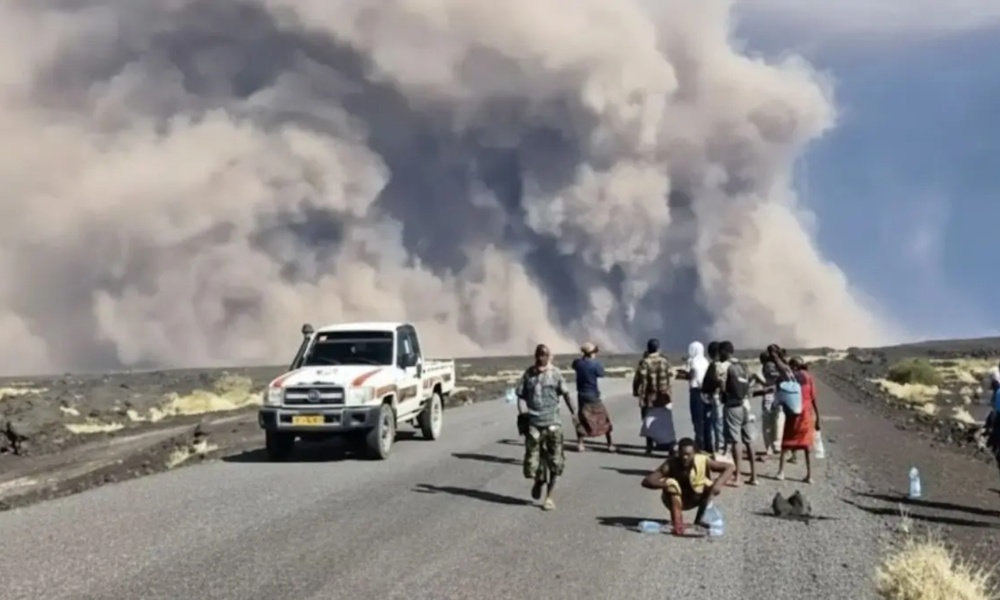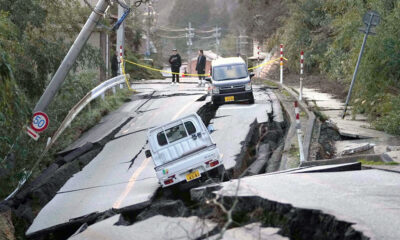Science & Technology
Google AI chief says there’s a 50% chance we’ll hit AGI in just 5 years

More than a decade ago, the co-founder of Google’s DeepMind artificial intelligence lab predicted that by 2028, AI will have a half-and-half shot of being about as smart as humans — and now, he’s holding firm on that forecast.
In an interview with tech podcaster Dwarkesh Patel, DeepMind co-founder Shane Legg said that he still thinks that researchers have a 50-50 chance of achieving artificial general intelligence (AGI), a stance he publicly announced at the very end of 2011 on his blog, Futurism reported.
It’s a notable prediction considering the exponentially growing interest in the space. OpenAI CEO Sam Altman has long advocated for an AGI, a hypothetical agent that is capable of accomplishing intellectual tasks as well as a human, that can be of benefit to all. But whether we’ll ever be able to get to that point — let alone agree on one definition of AGI — remains to be seen.
Legg apparently began looking towards his 2028 goalpost all the way back in 2001 after reading “The Age of Spiritual Machines,” the groundbreaking 1999 book by fellow Google AI luminary Ray Kurzweil that predicts a future of superhuman AIs.
“There were two really important points in his book that I came to believe as true,” he explained. “One is that computational power would grow exponentially for at least a few decades. And that the quantity of data in the world would grow exponentially for a few decades.”
Paired with an understanding of the trends of the era, such as the deep learning method of teaching algorithms to “think” and process data the way human brains do, Legg wrote back at the start of the last decade that in the coming ones, AGI could well be achieved — so long as “nothing crazy happens like a nuclear war.”
Today, the DeepMind co-founder said that there are caveats to his prediction that the AGI era will be upon us by the end of this decade.
The first, broadly, is that definitions of AGI are reliant on definitions of human intelligence — and that kind of thing is difficult to test precisely because the way we think is complicated.
“You’ll never have a complete set of everything that people can do,” Legg said — things like developing episodic memory, or the ability to recall complete “episodes” that happened in the past, or even understanding streaming video. But if researchers could assemble a battery of tests for human intelligence and an AI model were to perform well enough against them, he continued, then “you have an AGI.”
When Patel asked if there could be a single simple test to see whether an AI system had reached general intelligence, such as beating Minecraft, Legg pushed back.
“There is no one thing that would do it, because I think that’s the nature of it,” the AGI expert said. “It’s about general intelligence. So I’d have to make sure [an AI system] could do lots and lots of different things and it didn’t have a gap.”
The second biggest caveat, Legg added, was the ability to scale AI training models way, way up — a worthy point given how much energy AI companies are already using to churn out large language models like OpenAI’s GPT-4.
“There’s a lot of incentive to make a more scalable algorithm to harness all this computing data,” Legg explained. “So I thought it would be very likely that we’ll start to discover scalable algorithms to do this.”
Asked where he thought we stand today on the path to AGI, Legg said that he thinks computational power is where it needs to be to make it happen, and the “first unlocking step” would be to “start training models now with the scale of the data that is beyond what a human can experience in a lifetime” — a feat he believes the AI industry is ready to achieve.
All that said, Legg reiterated his personal stance that he only believes there’s a 50 percent chance researchers will achieve AGI before the end of this decade, and Futurism has reached out to DeepMind to see if the Google subsidiary has anything to add to that prognosis.
“I think it’s entirely plausible,” he said, “but I’m not going to be surprised if it doesn’t happen by then.”
Science & Technology
Australia social media ban set to take effect, sparking a global crackdown
For the social media businesses, the implementation marks a new era of structural stagnation as user numbers flatline and time spent on platforms shrinks, studies show.

Australia is set to become the first country to implement a minimum age for social media use on Wednesday, with platforms like Instagram, TikTok and YouTube forced to block more than a million accounts, marking the beginning of an expected global wave of regulation.
From midnight, 10 of the biggest platforms will be required to block Australians aged under 16 or be fined up to A$49.5 million ($33 million), Reuters reported.
The law received harsh criticism from major technology companies and free speech advocates, but was praised by parents and child advocates.
The rollout closes out a year of speculation about whether a country can block children from using technology that is built into modern life. And it begins a live experiment that will be studied globally by lawmakers who want to intervene directly because they are frustrated by what they say is a tech industry that has been too slow to implement effective harm-minimisation efforts.
Governments from Denmark to Malaysia – and even some states in the U.S., where platforms are rolling back trust and safety features – say they plan similar steps, four years after a leak of internal Meta (META.O) documents showed the company knew its products contributed to body image problems and suicidal thoughts among teenagers while publicly denying the link existed.
“While Australia is the first to adopt such restrictions, it is unlikely to be the last,” said Tama Leaver, a professor of internet studies at Curtin University.
“Governments around the world are watching how the power of Big Tech was successfully taken on. The social media ban in Australia … is very much the canary in the coal mine.”
A spokesperson for the British government, which in July began forcing websites hosting pornographic content to block under-18 users, said it was “closely monitoring Australia’s approach to age restrictions.”
“When it comes to children’s safety, nothing is off the table,” they added.
Few will scrutinise the impact as closely as the Australians. The eSafety Commissioner, an Australian regulator tasked with enforcing the ban, hired Stanford University and 11 academics to analyse data on thousands of young Australians covered by the ban for at least two years.
Though the ban covers 10 platforms initially, including Alphabet’s (GOOGL.O), YouTube, Meta’s Instagram and TikTok, the government has said the list will change as new products appear and young users switch to alternatives.
Of the initial 10, all but Elon Musk’s X have said they will comply using age inference – guessing a person’s age from their online activity – or age estimation, which is usually based on a selfie. They might also check with uploaded identification documents or linked bank account details.
Musk has said the ban “seems like a backdoor way to control access to the internet by all Australians” and most platforms have complained that it violates people’s right to free speech.
For the social media businesses, the implementation marks a new era of structural stagnation as user numbers flatline and time spent on platforms shrinks, studies show.
Platforms say they don’t make much money showing advertisements to under-16s, but they add that the ban interrupts a pipeline of future users. Just before the ban took effect, 86% of Australians aged 8 to 15 used social media, the government said.
“The days of social media being seen as a platform for unbridled self-expression, I think, are coming to an end,” said Terry Flew, the co-director of University of Sydney’s Centre for AI, Trust and Governance.
Platforms responded to negative headlines and regulatory threats with measures like a minimum age of 13 and extra privacy features for teenagers, but “if that had been the structure of social media in the boom period, I don’t think we’d be having this debate,” he added.
Science & Technology
Ethiopian volcano erupts for first time in nearly 12,000 years
Ash from the eruption drifted across the region, spreading over Yemen, Oman, India, and parts of Pakistan.

The Hayli Gubbi volcano in Ethiopia’s Afar region has erupted for the first time in almost 12,000 years, sending massive ash plumes soaring up to 14 kilometres into the atmosphere, according to the Toulouse Volcanic Ash Advisory Centre.
The eruption began on Sunday and lasted several hours. Hayli Gubbi, located around 800 kilometres northeast of Addis Ababa near the Eritrean border, sits within the geologically active Rift Valley, where two major tectonic plates meet. The volcano rises roughly 500 metres above the surrounding landscape.
Ash from the eruption drifted across the region, spreading over Yemen, Oman, India, and parts of Pakistan. Satellite imagery and social-media videos captured a towering column of white smoke billowing into the sky.
The Smithsonian Institution’s Global Volcanism Program notes that Hayli Gubbi has no recorded eruptions during the Holocene, the period dating back about 12,000 years to the end of the last Ice Age.
Volcanologist Simon Carn of Michigan Technological University also confirmed on Bluesky that the volcano had “no record of Holocene eruptions.”
Science & Technology
Cloudflare outage easing after millions of internet users affected

A global outage at web-infrastructure firm Cloudflare began to ease on Tuesday afternoon after preventing people from accessing major internet platforms, including X and ChatGPT.
Cloudflare, whose network handles around a fifth of web traffic, said it started to investigate the internal service degradation around 6:40 a.m. ET. It has deployed a fix but some customers might still be impacted as it recovers service.
The incident marked the latest hit to major online services. An outage of Amazon’s cloud service last month caused global turmoil as thousands of popular websites and apps, including Snapchat, were inaccessible due to the disruption.
Cloudflare – whose shares were down about 5% in premarket trading – runs one of the world’s largest networks that helps websites and apps load faster and stay online by protecting them from traffic surges and cyberattacks.
The latest outage prevented users from accessing platforms such as Canva, X, and ChatGPT, prompting users to log outage reports with Downdetector.
Downdetector tracks outages by collating status reports from a number of sources. “We saw a spike in unusual traffic to one of Cloudflare’s services beginning at 11:20 UTC. That caused some traffic passing through Cloudflare’s network to experience errors,” the company said in an emailed statement.
“We are all hands on deck to make sure all traffic is served without errors.”
X and ChatGPT-creator OpenAI did not immediately respond to requests for comment. – REUTERS
-

 Sport4 days ago
Sport4 days agoILT20: Desert Vipers edge Gulf Giants in historic super over thriller
-

 Latest News2 days ago
Latest News2 days agoMuttaqi: Afghanistan’s progress requires both religious and modern education
-

 Regional4 days ago
Regional4 days agoSix Pakistani soldiers killed in TTP attack in Kurram District
-

 Business4 days ago
Business4 days agoTrade bodies warn almost 11,000 Afghan transit containers stuck at Karachi port
-

 World4 days ago
World4 days agoPowerful 7.6 earthquake hits northern Japan, tsunami warnings issued
-

 Latest News3 days ago
Latest News3 days agoTrump calls Afghanistan a ‘hellhole’ country as US expands immigration restrictions
-

 Sport5 days ago
Sport5 days agoSorkh Poshan Khafi defeats Sarsabz Yashlar 4-0 in Afghanistan Champions League
-

 Sport3 days ago
Sport3 days agoCommanding wins for Arman FC and Sarsabz Yashlar in Afghanistan Champions League
























